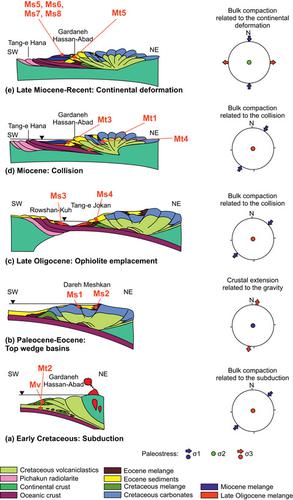当前位置:
X-MOL 学术
›
Basin Res.
›
论文详情
Our official English website, www.x-mol.net, welcomes your
feedback! (Note: you will need to create a separate account there.)
Mélange Development in the Neyriz Region of Zagros Orogen, Iran: Record of Convergence and Collision in the Neotethyan Realm
Basin Research ( IF 2.8 ) Pub Date : 2020-03-22 , DOI: 10.1111/bre.12445 Parisa Gholami Zadeh 1 , Mohammad Hossein Adabi 2 , Mohammad Reza Ghassemi 3 , Abbas Sadeghi 2 , Safar Ali Eshraghi 4
Basin Research ( IF 2.8 ) Pub Date : 2020-03-22 , DOI: 10.1111/bre.12445 Parisa Gholami Zadeh 1 , Mohammad Hossein Adabi 2 , Mohammad Reza Ghassemi 3 , Abbas Sadeghi 2 , Safar Ali Eshraghi 4
Affiliation

|
[A tectonic model for the evolution of the Zagros Orogenic Belt based on the different types of melanges in the Neyriz region. , Abstract Melanges are formed by sedimentary, tectonic and diapiric processes and are generally found in collisional belts. The Zagros Orogeny provides an intriguing geological laboratory for the study of melange‐forming processes during the progressive tectonic evolution of the Neotethys Ocean. Different types of tectonic and sedimentary melanges occur in specific structural positions within the Zagros orogenic belt in the Neyriz Region (Iran). Based on their block‐in‐matrix fabrics, and tectonostratigraphic positions, we differentiated 14 different melange types, which mark different episodes of the tectonic evolution of the Neyriz Region from the Cretaceous subduction to the Miocene collision. The Cretaceous subduction stage is recorded by volcanic‐sedimentary melanges (Mv). Sedimentary melanges characterized by megabreccia from the Cretaceous limestone (Ms1) and Eocene polymictic megabreccia (Ms2) represent epi‐nappe melanges formed during the Palaeocene–Eocene in wedge‐top basins. The ophiolite emplacement in the Oligocene resulted in local extensional tectonics in the upper part of the ophiolitic nappe, and deposition of a polymictic megabreccia (Ms3, Ms4). As the final production of the Neotethys Ocean closure and the Eurasian‐Arabian collision, the sedimentary melanges characterized by different types of chaotic rock units (Ms5, Ms6, Ms7 and Ms8 facies) were developed in front of the Cretaceous–Eocene nappes due to growth of the orogenic wedge in the Miocene. Our findings indicate that the recognition and distinction of different types of melange may provide additional constraints for a better understanding of the tectono‐sedimentary evolution of the Neotethyan region.]
中文翻译:

伊朗扎格罗斯造山带 Neyriz 地区的混色岩发育:新特提斯王国的交汇和碰撞记录
[基于内里兹地区不同类型混杂岩的扎格罗斯造山带演化构造模型. , 摘要 混杂岩是由沉积、构造和底辟过程形成的,通常存在于碰撞带中。扎格罗斯造山带为研究新特提斯洋渐进构造演化过程中的混杂形成过程提供了一个有趣的地质实验室。伊朗内里兹地区扎格罗斯造山带内的特定构造位置出现了不同类型的构造和沉积混杂岩。根据它们的块状矩阵结构和构造地层位置,我们区分了 14 种不同的混杂岩类型,它们标志着 Neyriz 地区从白垩纪俯冲到中新世碰撞构造演化的不同阶段。白垩纪俯冲阶段由火山-沉积混杂岩(Mv)记录。以白垩纪石灰岩巨角砾岩(Ms1)和始新世混杂巨角砾岩(Ms2)为特征的沉积混杂岩代表了古新世-始新世楔顶盆地中形成的外推覆混杂岩。渐新世蛇绿岩的侵位导致蛇绿岩推覆上部的局部伸展构造,并沉积了混杂的巨角砾岩(Ms3、Ms4)。作为新特提斯洋闭合和欧亚-阿拉伯碰撞的最终产物,在白垩纪-始新世推覆层前发育了以不同类型混沌岩单元(Ms5、Ms6、Ms7和Ms8相)为特征的沉积混杂岩中新世造山楔。
更新日期:2020-03-22
中文翻译:

伊朗扎格罗斯造山带 Neyriz 地区的混色岩发育:新特提斯王国的交汇和碰撞记录
[基于内里兹地区不同类型混杂岩的扎格罗斯造山带演化构造模型. , 摘要 混杂岩是由沉积、构造和底辟过程形成的,通常存在于碰撞带中。扎格罗斯造山带为研究新特提斯洋渐进构造演化过程中的混杂形成过程提供了一个有趣的地质实验室。伊朗内里兹地区扎格罗斯造山带内的特定构造位置出现了不同类型的构造和沉积混杂岩。根据它们的块状矩阵结构和构造地层位置,我们区分了 14 种不同的混杂岩类型,它们标志着 Neyriz 地区从白垩纪俯冲到中新世碰撞构造演化的不同阶段。白垩纪俯冲阶段由火山-沉积混杂岩(Mv)记录。以白垩纪石灰岩巨角砾岩(Ms1)和始新世混杂巨角砾岩(Ms2)为特征的沉积混杂岩代表了古新世-始新世楔顶盆地中形成的外推覆混杂岩。渐新世蛇绿岩的侵位导致蛇绿岩推覆上部的局部伸展构造,并沉积了混杂的巨角砾岩(Ms3、Ms4)。作为新特提斯洋闭合和欧亚-阿拉伯碰撞的最终产物,在白垩纪-始新世推覆层前发育了以不同类型混沌岩单元(Ms5、Ms6、Ms7和Ms8相)为特征的沉积混杂岩中新世造山楔。











































 京公网安备 11010802027423号
京公网安备 11010802027423号